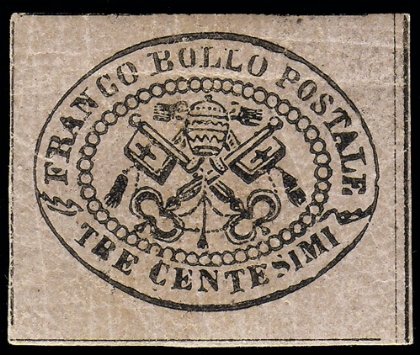The Papal Sovereign’s postal service is brought up to date Goodbye to bajocchi and scudi: it was June 18th 1866 – as specified in the book “Stato Pontificio 1852-1870” by A. Barcella, G. Bizzarri, A. and M. Zanaria – and Rome officially adopted the decimal metric system. With it, it took on a currency system based on the lira, which was divided into centesimi or cents. This event meant that new stamps were required. They were issued more than a year later, however, on September 21st 1867.
The seven denominations issued make up what philatelists know as the second of three series that were actually produced by the papal sovereign’s postal service. The stamps in this series are identical to the previous issue, except for the crossed keys and the papal tiara – however this time they were depicted in different frames and on paper in a selection of much brighter colours. As with the first series, which was issued in several stages between 1852 and 1864, this issue is also imperforate.
It contained seven basic denominations instead of the original eleven: the highest value was the 3 centesimi, which is known to exist in two shades: pink grey (it is more valuable new: the Sassone 2008 prices it at five thousand euros, considering it with incomplete gum); and grey (in this case, the most valuable are used stamps, on piece or on letter – priced at 12,500, 15,000 and 150 thousand euros respectively).
The green 3 centesimi is also worth a mention. It was never issued, due to a change in the rate for franking printed matter, which dropped to 2 centesimi following an agreement with the Italian post office. With only 6 existing pieces known of, valued by Sassone at 200,000 euros (for the defective pieces alone), this is the crowning glory of the Papal State collection and indeed of all the Italian States.
Zanaria has a wide range of guaranteed pieces: the pink grey, either new at 1500 euros or used at 1850 euros as well as the used grey at 4500 euros, the sheet corner 10 centesimi, new with gum intact, at 2500 euros compared to an evaluation in excess of 3600; and, of course, the prestigious 3 centesimi.
